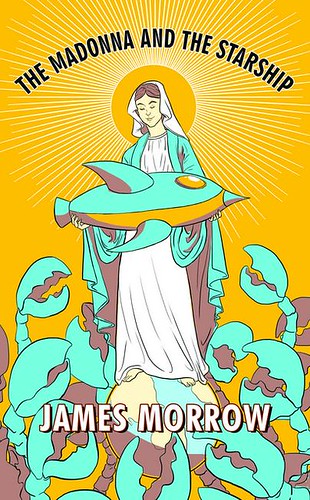 | |
| Cover Art & Design by Elizabeth Story |
My working relationship with author James Morrow dates back a good ten-plus years. In 2003 I included a reprint of his story "Auspicious Eggs" in my co-edited anthology Witpunk (with Claude Lalumière). Then in August 2008 I line/copy edited Morrow's novella Shambling Towards Hiroshima
(with Claude Lalumière). Then in August 2008 I line/copy edited Morrow's novella Shambling Towards Hiroshima , which was published by Tachyon Publications the following year. Shambling received critical praise, winning the Theodore Sturgeon Memorial Award in 2010, as well as being named a finalist for both the Nebula and Hugo awards. Also in 2010, my original Fermi paradox anthology, Is Anybody Out There?
, which was published by Tachyon Publications the following year. Shambling received critical praise, winning the Theodore Sturgeon Memorial Award in 2010, as well as being named a finalist for both the Nebula and Hugo awards. Also in 2010, my original Fermi paradox anthology, Is Anybody Out There? (co-edited with Nick Gevers) was published, for which Morrow wrote "The Vampires of Paradox," one of the more celebrated stories in the book.1
(co-edited with Nick Gevers) was published, for which Morrow wrote "The Vampires of Paradox," one of the more celebrated stories in the book.1
James Morrow is an absolute master of the sardonic, which was one of the reasons Claude and I selected his story for inclusion in Witpunk. (The other, primary reason, being that he is a master craftsman.) But a reader wouldn't need an anthology like Witpunk to know about the sardonic side of James Morrow: simply look at the individual titles of his stories -- "Auspicious Eggs," "The Vampires of Paradox," and "Shambling Towards Hiroshima." And his new book is no exception. The title? The Madonna and the Starship , forthcoming from Tachyon Pubs in early 2014.
, forthcoming from Tachyon Pubs in early 2014.
I recall the book launch event for Is Anybody Out There? at ReaderCon in Boston in July, 2010. In addition to James Morrow, authors Yves Meynard and Paul Di Filippo were on hand to read from their stories. My blog post "Readercon Recap," published on July 27, 2010, covers the details, but to quote from that post: "About five or so minutes into his reading, Jim [Morrow] reached under the table and -- surprising us all (myself included) -- brought forth a purplish brainlike thing with long tentacles, which he perched upon his shoulder as a visual representation of the parasitic cacodaemons in his story. Great bouts of laughter ensued."
Fast forward three years.... In late September I received an email from Jill Roberts at Tachyon Pubs informing me that James Morrow had requested that I work on his new novella. And two days later I received an email from the author himself: he would send me "a version of the file with a few new nips and tucks and tweaks" when I was ready....
So, here I am working on The Madonna and the Starship, a story that takes place in the early 1950s, the decade in which commercial television was finally affordable for mainstream America. Television sets first appeared in the Sears Roebuck catalog in 1949, and by 1950 nine percent of U.S. households could boast of owning a television set. By 1951 the television networks broadcast a total of twenty-seven hours of children's shows each week, and promoted the educational aspects of television to parents.2 Which brings me to Kurt Jastrow, the protagonist of our story. who is the head writer for the NBC children's program Brock Barton and His Rocket Rangers. In addition to cranking out weekly episodes of Brock Barton, Jastrow was also tasked with writing -- and starring in -- a ten-minute segment at the end of each episode: Uncle Wonder's Attic. Wearing a cardigan sweater and hiding behind a fake grizzled beard and equally fake eyebrows, Uncle Wonder would rummage around in his attic until he found just the right materials to perform some experiment related to the Brock Barton universe. Here's Kurt:
I liked my job. Just as our show enabled kids to fantasize that they were star sailors, so did my scripting duties allow me to imagine that I was a playwright, though I knew perfectly well that nobody was about to confuse a space schooner called the Triton with a streetcar named Desire.
But, Jastrow's day-to-day normalcy was interrupted by the arrival of two lobster-like aliens -- Wulawand and Volavont, from the planet Qualimosa in the Procyon system: a planet of "logical positivists." Unfortunately, this didn't bode well for Kurt Jastrow's love interest, Connie Osborne, who wrote and produced a Sunday morning religious program called Not By Bread Alone. Certain that the program's audience represented "a hive of irrationalist vermin," the Qualimosans planned to piggyback their death-ray onto the broadcast signal of Not By Bread Alone, to every NBC affiliate. Come Sunday morning, at ten minutes past ten o'clock, the Earth would be cleansed of nearly two million irrationalists.
Kurt and Connie now had less that two days to write, cast, and rehearse a replacement episode of Not By Bread Alone, one that was so perfectly rational and utterly absurd as to foil the Qualimosans' plans.
The Madonna and the Starship is available for preorder on Amazon.com.
is available for preorder on Amazon.com.
---------------
Footnotes:
1. This blog also has a dedicated Is Anybody Out There? page, which includes the complete text of six of the anthology's stories.
2. "Television History - A Timeline: 1878-2005," The University of Texas School of Law, Tarlton Law Library, Jamail Center for Legal Research.

No comments:
Post a Comment